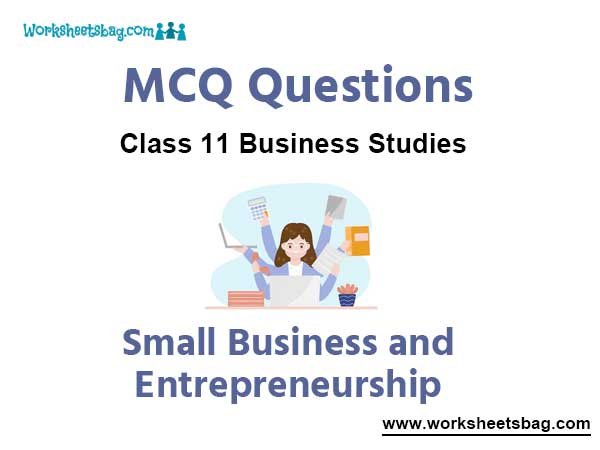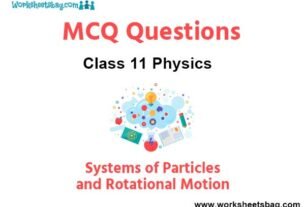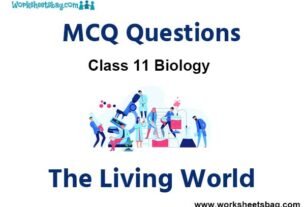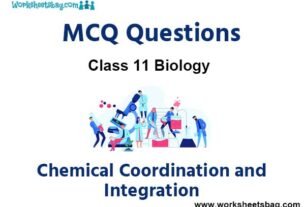Please refer to Small Business and Entrepreneurship MCQ Questions Class 11 Business Studies below. These MCQ questions for Class 11 Business Studies with answers have been designed as per the latest NCERT, CBSE books, and syllabus issued for the current academic year. These objective questions for Small Business and Entrepreneurship will help you to prepare for the exams and get more marks.
Small Business and Entrepreneurship MCQ Questions Class 11 Business Studies
Please see solved MCQ Questions for Small Business and Entrepreneurship in Class 11 Business Studies. All questions and answers have been prepared by expert faculty of standard 11 based on the latest examination guidelines.
MCQ Questions Class 11 Business Studies Small Business and Entrepreneurship
Question. Expand EOUs
(a) Essential Operating units
(b) Export Oriented units
(c) Export Order Units
(d) Essential order units
Answer
B
Question. The small scale industry can enjoy the status of ________ if it supplies not less than 50% of its production to another industry, referred to as the parent unit.
(a) Micro Business industry
(b) Export oriented unit
(c) Ancillary small industry
(d) Village industries
Answer
C
Question. Which of the following comes under the Modern Small Industries?
(a) Coir
(b) Powerlooms
(c) Handicrafts
(d) Khadi
Answer
B
Question. The small scale industry can enjoy the status of _______ unit if it exports more than 50% of its production.
(a) Import oriented units
(b) Export Oriented units
(c) Small scale unit
(d) Domestic unit
Answer
B
Question. ______ are also known as Rural industries or Traditional industries
(a) Agricultural industry
(b) Food industry
(c) Cottage Industries
(d) None of the above
Answer
C
Question. Expand DIC
(a) Directorate of Industry corporation
(b) Directorate of Indian Corporation
(c) District Industries Centers
(d) None of the above
Answer
C
Question. Exemption from paying taxes for 5 ot 10 years is known as _________
(a) Tax Deduction
(b) TDS
(c) Value Added Tax
(d) Tax Holiday
Answer
D
Question. In India, the ‘Village and Small Industries’ Sector consists of both traditional and modern small industries. This sector has ___________subgroups.
(a) Eleven
(b) Ten
(c) Five
(d) Eight
Answer
D
Question. A tiny unit is defined as an industrial or business enterprise whose investment in plant and machinery is not more than ___________
(a) Rs.35 Lakhs
(b) Rs.50 Lakhs
(c) Rs.30 Lakhs
(d) Rs. 25 Lakhs
Answer
D
Question. Expand SIDBI
(a) Society Industrial development bank of India
(b) Small Industries development bank of India
(c) Super Industrial development bank of India
(d) Small Indian Development bank of India
Answer
B
Question. Any industry located in a rural area which produces any goods renders any service with or without the use of power is known as ________
(a) City Industry
(b) Town Industry
(c) Village Industry
(d) District Industry
Answer
C
Question. The writing, listening and oral presentations skills possessed by an entrepreneur are more appropriately classified as _______.
(a) Technical Skills
(b) Business Management Skills
(c) Personal Entrepreneurial Skills
(d) None of these
Answer
A
Question. SBA stands for:
(a) Small business accountants
(b) Small business administration
(c) Small business adequacy
(d) Small business advisors
Answer
B
Question. The purpose of soft loan scheme is to encourage units to undertake _______.
(a) modernization of plant and machinery.
(b) replacement of plant and machinery.
(c) renovation of plant and machinery.
(d) all the above
Answer
D
Question. Limit of investment in small scale industry is ______
(a) One crore
(b) Ten crore
(c) Two crore
(d) Five crore
Answer
A
Question. The small scale industry can enjoy the status of ___________ if it supplies not less than 50% of its production to another industry, referred to as the parent unit.
(a) Village industries
(b) Micro Business industry
(c) Export oriented unit
(d) Ancillary small industry
Answer
D
Question. ___ is a person responsible for setting up a business.
(a) Entrepreneur
(b) Businessman
(c) Manager
(d) Planner
Answer
A
Question. Which of the following is part of the small-scale sector?
(a) Paper Products and Printing
(b) Food Products
(c) Cotton Textiles
(d) All of the above
Answer
D
Question. ______ Is defined as risk which can not be insured against and is incalculable.
(a) Unsecured Risk
(b) Uninsured Risk
(c) Incalculable Risk
(d) Uncertainty
Answer
D
Question. State Industrial corporations engage in the development of__________.
(a) industrial estates.
(b) institutional estates.
(c) individual investors.
(d) agricultural entrepreneurs.
Answer
A
Question. __________ is defined as one in which the investment in fixed assets of plant and machinery does not exceed rupees one crore.
(a) Small Scale Industry
(b) Limited Companies
(c) Large Scale industry
(d) None of the above
Answer
A
Question. Capital is arranged from Internal sources refers to the owner’s own money known as
(a) Profit
(b) Capital
(c) Equity
(d) None of the above
Answer
C
Question. _____ is a favorable set of circumstances that creates a need for a new product, service, or business.
(a) A niche
(b) A venture
(c) A trend
(d) An opportunity
Answer
D
Question. An industry located in a rural area which may/may not use power are known as:
(a) District industry
(b) Town industry
(c) City industry
(d) Village Industry
Answer
D
Question. The entrepreneur distinguished themselves from capital provider in
(a) Middle Ages
(b) 17th Century
(c) 18th Century
(d) 19th Century
Answer
C
Question. Any industry located in a rural area which produces any goods, renders any service with or without the use of power is known as ____
(a) City Industry
(b) Town Industry
(c) Village Industry
(d) District Industry
Answer
C
Question. NSIC was setup in
(a) 1982
(b) 1975
(c) 1965
(d) 1955
Answer
D
Question. National Alliance of Young Entrepreneurs (NAYE) Sponsored an Entrepreneurial Development scheme with Bank of India in______.
(a) January 1920.
(b) August 1920.
(c) January 1972.
(d) August 1972.
Answer
D
Question. Full form of DIC is:
(a) District Industries Centre
(b) Distant Industries Centre
(c) District Inclined Centre
(d) District Industries Conversion
Answer
A
Question. Which of the following is part of ?Village and Small Industries Sector?
(a) Handicrafts
(b) Sericulture
(c) Handlooms
(d) All of these
Answer
D
Question. The main objective of setting up DICs was to promote under a single roof all the services & support required by small & village entrepreneurs. This scheme was introduced in May
(a) 1970
(b) 1975
(c) 1978
(d) None of the above
Answer
C



